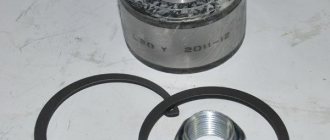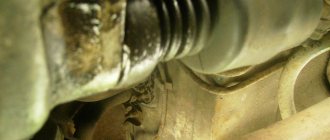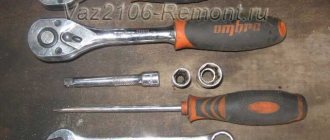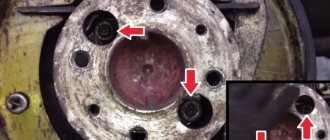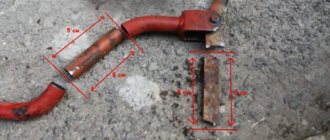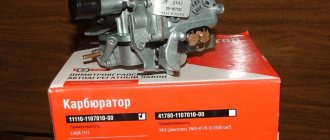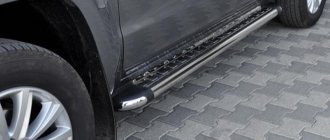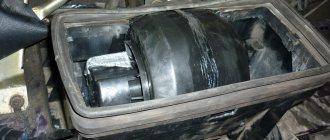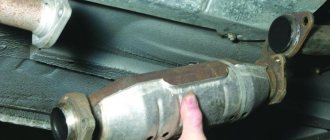What bearings are installed on VAZ 2108, 2109, 21099?
- Differential bearings - 2108-2303036-01;
- Steering shaft bearings - 2108-3401120;
- Front steering gear bearing - 2108-3401123;
- Upper support bearing of the front strut - 2108-2902840;
- Rear steering gear bearing - 2108-3401104;
- Rear bearing of the primary and secondary shaft of the gearbox - 2108-1701033;
- Intermediate bearing of the secondary shaft of the gearbox - 2108-1701108;
- Front bearing of the gearbox input shaft - 2108-1701031-01;
- Front bearing of the secondary gearbox shaft - 2108-1701180-01;
- Release bearing - 1111-1601182;
- Generator front bearing - 249402030;
- Generator rear bearing - 24940220;
- Timing belt tensioner bearing - 2108-1006120;
- Engine coolant pump bearing - 2108-1307027-12;
- Front wheel hub bearing - 2108-3103020-01;
- Rear wheel hub bearing - 2108-3104020.
Cause of wheel bearing failures
Wheel bearings on the VAZ 2109 are parts that often need replacement, a weak link. But the main reason for this weakness is not even the quality of the products (although this also matters), but the quality of the domestic road surface in most regions.
On average, manufacturers promise 100,000 km of mileage for their products, however, wheel bearings on a VAZ 2109 have to be changed much earlier. In terms of domestic roads, this is 50,000, maximum 60,000 km.
On the VAZ 2109 there is no turning of the rear axle, and the hubs are rigidly attached to the suspension. The bearing in the hub is pressed tightly, ensuring smooth rotation of the hub itself on the shaft. There should be no play, crunching, or jamming in this design; it is responsible for the rotation of the wheel. A strong blow to the suspension often leads to damage to the wheel bearings; reckless off-road driving has a bad effect on the chassis.
Torque is transmitted to the drive wheels through the gearbox from the engine; if the wheel bearings fail, this can lead to jamming and a complete stop of the wheel. So, it is best to take care of the need to replace the wheel bearing on a VAZ 2109 in advance.
Reasons for premature wear of a part:
- Off-road driving, especially careless driving. A sudden hit of a wheel in a pothole, a hole, “shock” overcoming potholes and potholes at high speed.
- No lubricant or insufficient amount. The cause of loss of lubricant is damage to the protective boots, the lubricant leaks, and the bearing wears out and fails prematurely. Damage to the seals also leads to loss of lubrication.
- Too much grease.
- The quality of the lubricant is low or it is not suitable for this model.
- Frequent overheating of the hub mechanism.
- When replacing the bearing, the tightening was done incorrectly. An overtightened hub nut (thermal clearance regulator) leads to failure of the cone bearing units due to friction and overheating. If the tightening is weak, the bearings break due to the resulting play and runout.
- Incorrect, uneven, distorted pressing. As a result, the loads on the bearing are uneven, wear is also uneven, and the operation of the element is unreliable.
- Driving through puddles, wet mud, “belly-deep”, at high speed. Dirt gets into all seams and joints, moisture washes away the lubricant, the metal undergoes oxidation and corrosion, friction increases, causing overheating of the mechanism.
- Tires have not been balanced. The beating that occurs without this is transmitted not only to the hub bearings, it is also noticeable in the cabin. The bearings acquire unacceptable play and are destroyed.
- The size of disks and wheels is unacceptable for the design. When increasing the weight of the wheel (larger ones weigh more), and installing beautiful large disks, it is necessary to take into account the permissible loads from such a design on the hub mechanism. If there is a mismatch, the bearings will fail quickly.
- Overloads under the influence of multidirectional forces of rotation and braking, turns, in the case of the front wheels. Malfunctions of the brake system, sudden braking, and problems with steering increase the load on the bearings and also lead to their failure.
- Problems with shock absorbers. In this case, the mechanism experiences excessive, uneven shock loads.
Of course, if you drive carefully, the wheel bearings on the VAZ 2109 will require replacement after the 100,000 km specified by the manufacturers; any part has its own service life. One way or another, the need for replacement is determined by a number of characteristic signs. It is advisable to know them in order to change the wheel bearing on a VAZ 2109 in time, but not to allow unscrupulous service station specialists to impose an expensive, unnecessary service.
Wheel bearing 2108, 2109, 21099
Rear hub bearing 2108, 2109, 21099
Characteristics: ball, angular contact, double-row, closed type, sealed on both sides.
Designation (article) of the rear wheel hub bearing:
- According to VAZ classification - 2108-3104020;
- According to the classification of the bearing plant (GPZ) - 6-256706E1C17.
Dimensions of bearing 2108-3104020 rear hub VAZ 2108, 2109, 21099:
- Outer diameter D - 60 mm;
- Inner diameter d - 30 mm;
- Thickness B - 37 mm.
Technical characteristics of wheel bearing 2108-3104020:
| Accuracy class | 6 |
| Separator | polymeric |
| GOST | 520, 520-2011 |
| Country of origin | Russia |
| Weight | 0,407 |
Installation location of the rear wheel bearing for VAZ 2108, 2109, 21099:
Front wheel bearing 2108, 2109
Characteristics: ball, angular contact, double-row, closed type, sealed on both sides.
Designation (article) of the front hub bearing:
- According to VAZ classification - 2108-3103020-01, 2108-3103020-02;
- According to the classification of the bearing plant (GPZ) - 6-256907AE7C17, 6 - 256907E9C17.
Bearing dimensions 2108-3103020-01 front hub VAZ 2108, 2109, 21099:
- Outer diameter D - 64 mm;
- Inner diameter d - 34 mm;
- Thickness B - 37 mm.
Technical characteristics of the front hub bearing 2108-3103020-01:
| GOST | 831-75, 8995-75 |
| Country of origin | Russia |
| Manufacturer | GPZ - 3 |
| Number of tracks | 2 |
| Seal | On both sides |
| Weight | 0,445 |
Installation location of the front wheel bearing for VAZ 2108, 2109, 21099:
Front strut support bearing 2108, 2109, 21099
Characteristics: ball, angular contact, single-row, closed type, sealed on both sides.
Designation (article) of the support bearing of the front strut of VAZ 2108, 2109, 21099:
- According to VAZ classification - 2108-2902840, 2108-2902840-01;
- According to the classification of the bearing plant (GPZ) - 348702C17, 6 - 348702C17.
Dimensions of support bearing 2108-2902840 front strut VAZ 2108, 2109, 21099:
- Outer diameter D - 52 mm;
- Inner diameter d - 14.5 mm;
- Thickness B - 14 mm.
Technical characteristics of the front strut support bearing 2108-2902840:
| GOST | 831-75, 8995-75 |
| Country of origin | Russia |
| Manufacturer | GPZ - 23 |
| Number of tracks | 1 |
| Seal | No |
| Weight | 0,181 |
Installation location of support bearing 2108-2902840 front strut VAZ 2108, 2109, 21099:
Preparatory activities before replacement
Regardless of the chosen replacement option, you will need a minimum set of tools:
- Large screwdriver.
- Keys: 17, 13, 10.
- Hexagon 10.
- Hammer and chisel.
- A long 30mm wrench or a 30mm socket with a knob.
- Wheel puller for VAZ (photo).
- Mandrels (or heads) for knocking out the old part from the hub.
- Torque wrench.
We prepare the car, place it on a flat surface, you will also need bright lighting. You will complete all the work faster with an assistant, and also if you use an inspection hole (overpass). Put the car in first gear, and be sure to put chocks under the rear wheels.
Advice: The first, more efficient and high-quality replacement option is recommended for work, since pressing in and out is done using a removable device, in a shock-free manner.
Tools and materials for work
- Wheel chocks;
- Socket head for nine, thirteen, fifteen, nineteen, thirty;
- Power wrench;
- Jack;
- Wheel bolt wrench;
- Car stand;
- Nineteen spanner;
- Penetrating lubricant;
- Ratchet driver;
- Kardanchik;
- Extension;
- Pliers;
- Vise;
- Torque wrench;
- Extensions for dismantling and installing bearings;
- Hammer;
- Deep head for seven;
- Slotted screwdriver;
- Rubber hammer;
- Bulgarian;
- Chisel;
- Circlip pliers;
- Lithium grease.
This is interesting: Misfire in a cylinder: what to do if the order is disturbed
Sequencing
- First of all, the car should be in first gear, after which the car is put on the handbrake. Wheel chocks must be placed under the rear wheels.
- The car is jacked up, the wheel, in the hub of which the bearing is damaged, is removed.
The car is on a jack, the wheel is removed, the hub is visible
- Use a 30 mm socket wrench to unscrew the wheel bearing nut.
The nut is unscrewed with a 30mm head
- Using a flat screwdriver, pry up the caliper, then it should be unscrewed from the steering knuckle (for this, use a 17 mm spanner).
- The unscrewed caliper should be tied with something (otherwise it will hang on the brake hose and this hose may come off under its weight). You should also unscrew the brake disc from the hub.
- Now you need to remove the wheel bearing itself. To get to it, you must first remove the steering knuckle, which will require unscrewing a couple of bolts that secure the knuckle to the car's ball joint.
Use a spanner to unscrew the ball joint bolts
- Using an attachment of a suitable diameter (you can use a piece of steel pipe of the required diameter as this attachment), you should knock the hub out of the bearing, after which you need to remove the retaining ring (pliers are excellent for removing the retaining ring).
It is better to knock out the hub with a pipe of suitable diameter
The best way to remove the ring is with pliers.
- Now you need to press out the bearing. This is done using a puller pre-clamped in a vice.
Pressing out the bearing with a puller
The bearing was successfully pressed out by the puller
- After pressing out the bearing, the place where it was located must be thoroughly cleaned of rust and dirt, and then lubricated.
- The new wheel bearing is pressed into the steering knuckle using a vice and a puller, and the retaining ring is installed in place.
- The knuckle with the new bearing is screwed back to the ball joint, the unit is reassembled, and the wheel is installed in place.
Gearbox bearings 2108, 2109, 21099
Front bearing gearbox 2108, 2109, 21099 input shaft
Description: roller, radial, single-row.
Designation (article) of the roller front bearing of the input shaft of the VAZ 2108, 2109, 21099 gearbox:
- According to VAZ classification - 2108-1701031-01, 2108-1701031-02, 2108-1701031-03, 2108-1701031-04;
- According to the classification of the bearing plant (GPZ) - B66-42205AEM1SH1, 6-42205A1EUSH1, 6-42205A1E1USH1.
Dimensions of the front bearing 2108-1701031-01 of the input shaft of the VAZ 2108, 2109, 21099 gearbox:
- Outer diameter D - 52 mm;
- Inner diameter d - 25 mm;
- Thickness B - 15 mm.
Technical characteristics of the front bearing 2108-1701031-01 of the input shaft of the VAZ 2108, 2109, 21099 gearbox:
| GOST | 6364-78, 5721-25, 24696-81, 5377-79 |
| Country of origin | Russia |
| Manufacturer | GPZ - 4 |
| Number of tracks | 1 |
| Seal | No |
| Weight | 0,139 |
Installation location of the front bearing 2108-1701031-01 of the input shaft of the VAZ 2108, 2109, 21099 gearbox:
Rear gearbox bearing 2108, 2109, 21099 input shaft
Description: ball, radial, single-row.
Designation (article) of the rear ball bearing of the input shaft of the VAZ 2108, 2109, 21099 gearbox:
- According to VAZ classification - 2108-1701033, 2108-1701033-02, 2108-1701033-03;
- According to the classification of the bearing plant (GPZ) - B6-50305A1E, B6-50305A1E-1, 6-50305AE-1.
Dimensions of the rear bearing 2108-1701033 of the input shaft of the VAZ 2108, 2109, 21099 gearbox:
- Outer diameter D - 62 mm;
- Inner diameter d - 25 mm;
- Thickness B - 17 mm.
Technical characteristics of the rear bearing 2108-1701033 of the input shaft of the VAZ 2108, 2109, 21099 gearbox:
| GOST | 8338-75; 520-2011 |
| Country of origin | Russia |
| Accuracy class | 0 |
| Manufacturer | GPZ - 3 |
| Number of tracks | 1 |
| Seal | No |
| Weight | 0,238 |
Installation location of the rear bearing 2108-1701031-01 of the input shaft of the VAZ 2108, 2109, 21099 gearbox:
Front bearing of the secondary shaft of the gearbox
Description: roller, radial, single-row.
Designation (article number) of the roller front bearing of the secondary shaft of the VAZ 2108, 2109, 21099 gearbox:
- According to VAZ classification - 2108-1701180-01, 2108-1701180-02, 2108-1701180-03, 2108-1701180-04;
- According to the classification of the bearing plant (GPZ) - 6-42305AEУШ1, 6-42305AE1УШ1, B6-42305AEMШ1.
Dimensions of the front bearing 2108-1701180-01 of the secondary shaft of the VAZ 2108, 2109, 21099 gearbox:
- Outer diameter D - 62 mm;
- Inner diameter d - 25 mm;
- Thickness B - 17 mm.
Technical characteristics of the front bearing 2108-1701180-01 of the secondary shaft of the VAZ 2108, 2109, 21099 gearbox:
| GOST | 6364-78, 5721-25, 24696-81, 5377-79 |
| Country of origin | Russia |
| Manufacturer | GPZ - 4 |
| Number of tracks | 1 |
| Seal | No |
| Weight | 0,262 |
Installation location of the front bearing 2108-1701180-01 of the secondary shaft of the VAZ 2108, 2109, 21099 gearbox:
Rear bearing of the secondary shaft of the VAZ 2108, 2109, 21099 gearbox
Description: ball, radial, single-row.
Designation (article) of the rear ball bearing of the secondary shaft of the VAZ 2108, 2109, 21099 gearbox:
- According to VAZ classification - 2108-1701033, 2108-1701033-02, 2108-1701033-03;
- According to the classification of the bearing plant (GPZ) - B6-50305A1E, B6-50305A1E-1, 6-50305AE-1.
Dimensions of the rear bearing 2108-1701033-02 of the secondary shaft of the VAZ 2108, 2109, 21099 gearbox:
- Outer diameter D - 62 mm;
- Inner diameter d - 25 mm;
- Thickness B - 17 mm.
Technical characteristics of the rear bearing 2108-1701033-02 of the secondary shaft of the VAZ 2108, 2109, 21099 gearbox:
| GOST | 8338-75; 520-2011 |
| Country of origin | Russia |
| Accuracy class | 0 |
| Manufacturer | GPZ - 3 |
| Number of tracks | 1 |
| Seal | No |
| Weight | 0,238 |
Installation location of the rear bearing 2108-1701033-02 of the secondary shaft of the VAZ 2108, 2109, 21099 gearbox:
Needle bearings of the secondary shaft of the gearbox 2108, 2109, 21099
Description: roller, needle, single-row.
Designation (article) of the needle bearing of the gearbox secondary shaft VAZ 2108, 2109, 21099:
- According to VAZ classification - 2108-1701108, 2108-1701108-01, 2108-1701108-02, 2108-1701108-03;
- According to the classification of the bearing plant (GPZ) - 464706E1.
Dimensions of needle bearing 2108-1701108 of the gearbox secondary shaft VAZ 2108, 2109, 21099:
- Outer diameter D - 37 mm;
- Inner diameter d - 32 mm;
- Thickness B - 27 mm.
Technical characteristics of the needle bearing 2108-1701108 of the secondary shaft gears of the VAZ 2108, 2109, 21099 gearbox:
| GOST | 4657-82 |
| Country of origin | Russia |
| Number of tracks | 1 |
| Seal | No |
| Weight | 0,023 |
Installation location of the needle bearing 2108-1701108 of the secondary shaft gears of the VAZ 2108, 2109, 21099 gearbox:
Instructions for removing the hub assembly from the rear axle
- We turn off the engine, put the car in gear, and install stops under the front axle.
- We jack up the wheel we need.
- We tear off the mounting bolts and remove the removed wheel.
- Now we have access to the brake drum. Using a “12” wrench, unscrew the pin guides and remove it. The brake drum may be firmly in place. Then WD-40 universal lubricant will come to the rescue. And if the knot is stuck too tightly, you can remove it with a hammer or mallet, gently tapping it around the perimeter.
- Unscrew the hub nut.
- We remove the hub using a special two-jaw puller for VAZ bearings. If you don’t have one, you can simply screw the wheel to the axle and then quickly pull it off.
Note:
As a result of manipulation, the ball bearing should easily come off the axle. But it happens that only the outer ring comes off, while the inner ring of the bearing remains in place. In this case, the brake pads will need to be dismantled, and the remaining part must be removed from the seat using a chisel.
Steering bearing 2108, 2109, 21099
Steering shaft bearing VAZ 2108, 2109, 21099
Description: ball, single row, radial.
Designation (article) of the steering shaft bearing VAZ 2108, 2109, 21099:
- According to VAZ classification - 2108-3401120;
- According to the classification of the bearing plant (GPZ) - 930904.
Dimensions of bearing 2108-3401120 steering shaft VAZ 2108, 2109, 21099:
- Outer diameter D - 37 mm;
- Inner diameter d - 21.6 mm;
- Thickness B - 11, mm.
Technical characteristics of bearing 2108-3401120 steering shaft VAZ 2108, 2109, 21099:
| Country of origin | Russia |
| Manufacturer | APZ-20 |
| Number of tracks | 1 |
| Number of balls in the bearing | 16 |
| Ball diameter | 3.175 mm |
| Dynamic load capacity | 3.12 kN |
| Static load capacity | 1.98 kN |
| Rotation frequency | 20000 rpm |
| Seal | No |
| Weight | 0,022 |
Installation location of bearing 2108-3401120 steering shaft VAZ 2108, 2109, 21099:
Front steering gear bearing
Description: ball, single row, radial.
Designation (article) of the front bearing of the steering gear VAZ 2108, 2109, 21099:
- According to VAZ classification - 2108-3401123, 2108-3401123-01, 2108-3401123-02;
- According to GOST - 80-903E.
Dimensions of the front bearing 80-903E steering gear VAZ 2108, 2109, 21099:
- Outer diameter D - 35 mm;
- Inner diameter d - 17.7 mm;
- Thickness B - 8 mm.
Technical characteristics of the front bearing 80-903E steering gear VAZ 2108, 2109, 21099:
| Country of origin | Russia |
| GOST | 9592-75, 28428-90 |
| Manufacturer | GPZ-20, GPZ-23 |
| Number of tracks | 1 |
| Seal | No |
| Weight | 0,029 |
Installation location of the front bearing 80-903E steering gear VAZ 2108, 2109, 21099:
Rear steering gear bearing
Description: roller, needle, single-row, radial.
Designation (article) of the rear bearing of the steering gear VAZ 2108, 2109, 21099:
- According to VAZ classification - 2108-3401104;
- According to GOST - 604901US17.
Dimensions of rear bearing 2108-3401104 steering gear VAZ 2108, 2109, 21099:
- Outer diameter D - 17.46 mm;
- Inner diameter d - 15.11 mm;
- Thickness B - 13 mm.
Technical characteristics of the rear bearing 2108-3401104 steering gear VAZ 2108, 2109, 21099:
| Country of origin | Russia |
| GOST | 4657-82 |
| Number of tracks | 1 |
| Seal | No |
| Weight | 0,009 |
Installation location of rear bearing 2108-3401104 steering gear VAZ 2108, 2109, 21099:
Diagnosis of wheel bearing failure
Signs of a problem appear, first of all, in the noise accompanying the movement. The sound of an accelerating subway train is what the whine that arises most resembles; it can come from one side or both; its appearance in the noise of the chassis clearly indicates the appearance of problems in the hub mechanism. At the very beginning, the problem makes itself felt at a speed of 50 km/h, during acceleration and when cornering, the noise will intensify.
Listen to what a bad wheel bearing sounds like in this video:
It is important not to confuse noise from bearings and a similar noise “alarm” from a gearbox or rear axle gearbox. The similarity is great, however, the transmission “makes itself known” at the start, during acceleration, and when changing driving modes. Wheel bearings provide a constant “sound effect”, to which knocking and other characteristic noises and vibrations are later added.
If you detect characteristic noises, you should try to eliminate the problem by simply tightening the hub nut. Then you need to check the unit, most likely there will be no more noise. But this is an option that will help you get to a workshop or other place for repairs without any problems. The braces are enough for 100 – 200 km of travel.
Signs that it’s time to change the wheel bearings on a VAZ 2109:
- When driving, especially when turning, there is a characteristic noise that turns into a howl, as well as knocking, crunching, and rattling. May only occur on one side. By the way, if you can already hear a grinding or crunching sound, the bearing is broken, and replacement is urgently needed, metal particles that have broken off from the mechanism crunch.
- Vibration is noticeable in the cabin itself. It is transmitted from damaged hubs to the steering wheel and body. Usually this is a sign that for some reason there is little lubricant left in the bearing, but it is clogged with dirt. Getting dirt and foreign objects inside the bearings causes chipping and destruction of the material of the balls and rings.
- Brake pedal vibrations.
- Any extraneous sounds from the suspension mechanisms, it is better to immediately check the condition of the hub assembly.
- The front bearings, by knocking and vibration, warn of strong play; a hum indicates poor condition, wear of the separators, rings or rollers.
Driving at a low (about 50 km/h) speed, like a “snake,” helps to find out which bearing is damaged. In this case, you need to carefully listen to the noises that arise when turning, they will indicate a problem unit. You also need to listen to which axle, front or rear, here a sharp turn will help identify the problem in the front hub.
To finally clarify the possible problems of suspicious nodes, you need to:
- lift the wheel with a jack;
- check the wheel itself for play without removing it, pull it towards you, away from you, in different planes, if the unit is in order, there will be no play (strong, small within acceptable limits);
- to be sure that the problem is in the bearing, it is necessary for someone to depress the brake when checking; if there is no play with the pedal pressed, the bearing must be replaced;
- by manually rotating the wheel, make sure that there is noise or absence of noise in the mechanism; the wheel should rotate smoothly, silently, without jamming or vibration;
- the damaged part heats up more, this can be verified by touch;
- with the wheel and brake disc removed, the play of the hub itself is checked; it must also be moved manually, towards the axle; strong play indicates the need for replacement;
It is important to pay attention to such a malfunction in a timely manner; driving with noise and vibration brings discomfort to passengers and the driver. In the absence of timely repairs, the destruction of the front bearing will lead to large play. The wheel starts to wobble and the car loses control.
The rear bearing will simply immobilize the car, jamming the wheel. In addition, as a result of such a breakdown, over time the entire rack will certainly suffer, then repairs will be more difficult and also much more expensive.
Release bearing 2108, 2109, 21099
Description: ball, radial, single-row.
Designation (article) of the release bearing VAZ 2108, 2109, 21099:
- According to VAZ classification - 1111-1601182, 2109-1601182;
- According to GOST - 6-520806KEChC30, 76520806K1C28Ш1.
Dimensions of release bearing 2109-1601182 VAZ 2108, 2109, 21099:
- Outer diameter D - 55 mm;
- Inner diameter d - 31 mm;
- Thickness B - 13 mm.
Technical characteristics of the release bearing 2109-1601182 VAZ 2108, 2109, 21099:
| Country of origin | Russia |
| Manufacturer | GPZ-20 |
| GOST | 9592-75, 28428-90 |
| Number of tracks | 1 |
| Seal | Eat |
| Weight | 0,13 |
Installation location of release bearing 2109-1601182 VAZ 2108, 2109, 21099:
What drives can be installed
When planning to replace old steel wheels with alloy wheels, you should choose either original products or products from well-known manufacturers who care about the quality and safety of their products.
Alloy wheels combine the following useful properties: they are lightweight, practical to use, endowed with sufficient strength and have an attractive appearance, which is aimed at transforming the entire appearance of the car.
The most common among alloy wheels are aluminum products. This is due to the fact that they are resistant to corrosion, meet strength requirements and, in comparison with other alloy wheels, remain relatively inexpensive.
Titanium alloy is the most expensive option. It also meets all the technical specifications, but at the same time has a more attractive appearance. In third place is the option using a magnesium alloy.
The latest models from AvtoVAZ use wheels with a 4x100 mounting pattern. When installing them on a 4x98 hub, you should use studs with an eccentric to compensate for the difference of 2 mm. To install disks with other mounting patterns, you will have to use the appropriate adapters (spacers).
You must understand that installing wheels larger than 15 inches is impossible without interfering with the car’s design.
Differential bearing 2108, 2109, 21099
Description: roller, angular contact, single row.
Designation (article) of the differential bearing VAZ 2108, 2109, 21099:
- According to VAZ classification - 2108-2303036-01, 2108-2303036-02, 2108-2303036-03;
- According to GOST - 6U-7207AK, 6U-7207AK1.
Dimensions of bearing 6U-7207AK differential VAZ 2108, 2109, 21099:
- Outer diameter D - 72 mm;
- Inner diameter d - 35 mm;
- Thickness B - 18.25 mm.
Technical characteristics of bearing 6U-7207AK differential VAZ 2108, 2109, 21099:
| Country of origin | Russia |
| Manufacturer | GPZ-9 |
| GOST | 27365-87, 6364-78, 8419-75 |
| Number of tracks | 1 |
| Seal | No |
| Weight | 0,326 |
Installation location of bearing 6U-7207AK differential VAZ 2108, 2109, 21099:
Scope of application
Bearings with a spiral groove for lubrication are used in conditions of severe clogging and significant loads.
Made from specialized steels and subjected to heat treatment. Maintenance parameters for roller bearings depend on their type. After completing the installation of the roller bearing, tests are performed. Initially, a small load is applied at a low frequency. A slightly audible, uniform noise indicates stable operation of the roller bearing. A significant rise in temperature and a sharp sound indicate an incorrect clearance in the bearing.
Roller bearings are used in gearboxes and high-power motors. Roller bearings 2109 are equipped with axle boxes on the axles of railway platform bogies. Roller bearings are used in rotating units of metalworking mechanisms. Roller bearings are found in transmissions of cars and trucks.
Generator bearing 2108, 2109
Generator front bearing
Description: ball, angular contact, single-row, closed.
Designation (article) of the front bearing of the VAZ 2108, 2109, 21099 generator:
- According to VAZ classification - 249402030;
- According to GOST - 6-180302U.
Dimensions of the front bearing 6-180302U of the VAZ 2108, 2109, 21099 generator:
- Outer diameter D - 42 mm;
- Inner diameter d - 15 mm;
- Thickness B - 13 mm.
Technical characteristics of the front bearing 6-180302U of the VAZ 2108, 2109, 21099 generator:
| Country of origin | Russia |
| Manufacturer | GPZ-4 |
| GOST | 9592-75, 28428-90 |
| Number of tracks | 1 |
| Seal | There is |
| Weight | 0,084 |
Installation location of the front bearing 6-180302U of the VAZ 2108, 2109, 21099 generator:
Generator rear bearing
Description: ball, radial, single-row, closed, with double-sided seal.
Designation (article) of the rear bearing of the VAZ 2108, 2109, 21099 generator:
- According to VAZ classification - 24940220;
- According to GOST - 6-180201U.
Dimensions of the rear bearing 6-180201U of the VAZ 2108, 2109, 21099 generator:
- Outer diameter D - 32 mm;
- Inner diameter d - 15 mm;
- Thickness B - 10 mm.
Technical characteristics of the rear bearing 6-180201U generator VAZ 2108, 2109, 21099:
| Country of origin | Russia |
| Manufacturer | GPZ-4 |
| GOST | 9592-75, 28428-90 |
| Number of tracks | 1 |
| Accuracy class | 6 |
| Separator | steel |
| Seal | There is |
| Weight | 0,0375 |
Installation location of the rear bearing 6-180201U of the VAZ 2108, 2109, 21099 generator:
DIY rear wheel hub replacement
You can also replace the rear wheel hub yourself. You will need standard tools - wrenches, a small screwdriver, a jack, and so on. The installation algorithm is as follows:
- Take a wrench and loosen the nuts.
- Use a jack to raise the car.
- Take the wrench again, unscrew the nuts completely and remove the flywheel.
- Have someone hold down the brake pedal or place something heavy on the brake to hold the pedal in place.
- Carefully unscrew the nut and remove the brake cylinder and caliper.
- If the car has an ABS/VDC sensor, then take a 10mm socket and unscrew the bolt. Don't forget to clean the sensor from dirt.
- Remove the car from the brake, and then turn the flywheel so that the rubber cap is on the bottom. Put the car on the brakes again.
- Remove the cap, insert a small screwdriver into the hole and turn the gear wheel up until it stops.
- Remove the brake disc.
- If necessary, remove the parking brake pads.
- Find the 4 bolts on the back of the hub unit and unscrew them.
- Carefully remove the hub part (do not damage the rear wheel hub axle).
- Dismantling is complete. To install a new part, you need to perform the same steps, but in reverse order.
- In case of replacement, you can also use a hammer and a wheel nut to knock out 4 or 5 studs from the old part - the studs are quite expensive and they break relatively often, so it won't hurt to remove them.
Pump bearing 2108, 2109, 21099
Description: ball, radial, single-row, closed, with double-sided seal.
Designation (article) of the pump bearing VAZ 2108, 2109, 21099:
- According to VAZ classification - 2108-1307027-12, 2108-1307027-13, 2110-1307027;
- According to GOST - 6-4224703EC17, 6-1HP16092EC30, 6-1HP16092KC30.
Dimensions of bearing 6-4224703EC17 pump VAZ 2108, 2109, 21099:
- Outer diameter D - 30 mm;
- Inner diameter d - 16 mm;
- Thickness B - 39 mm.
Technical characteristics of bearing 6-4224703EC17 pump VAZ 2108, 2109, 21099:
| Country of origin | Russia |
| Manufacturer | GPZ-11 |
| Number of tracks | 1 |
| Separator | steel |
| Seal | There is |
Installation location of bearing 6-4224703EC17 for VAZ 2108, 2109, 21099 pump:
Design and purpose of hubs
The VAZ-2108 moves due to the fact that from the running engine, through mechanical transmissions, torque is transmitted to the drive wheels (in this case, the front wheels). But if the connection between the wheels, axles and the frame is rigid, then movement on an uneven surface will simply become impossible. In addition, all components will quickly fail as a result of colossal shock loads.
To prevent this, a system of intermediate links (levers), or suspension, is used. It should smooth out the effect of road surface irregularities on the ride. Its final unit, to which the wheel is attached, is the hub. This is a cylindrical housing part that is installed on the drive and driven shafts. Between the hub and the shaft there is a bearing, which allows the wheel to rotate.
The main functions of this node are:
Structurally, any hub consists of the following components:
- Outer rim. Made in the shape of a glass with holes for exiting and fixing the axle shaft, as well as the wheel disk.
- Bearing cup. In fact, this is not a separate unit, but just the inner part of the rim, which has the necessary dimensions for installing rotation supports.
- Slotted hole. Again, part of the rim is the central hole in it, which has a spline for installing and fixing the axle shaft.
The wheel hub is formed from a cast blank by machining the seating surfaces.
